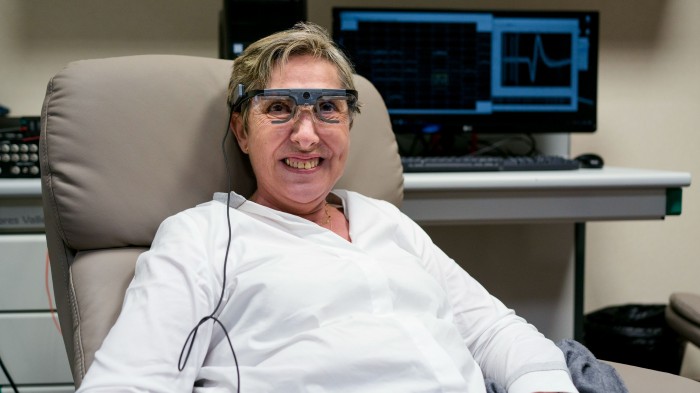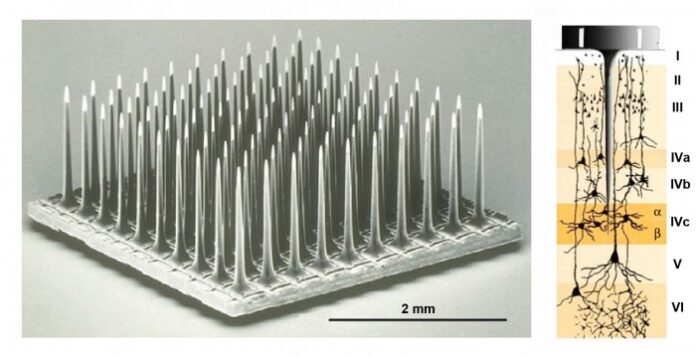
Gómez is blind and she’s been that way for over a decade. When she was 42, toxic optic neuropathy destroyed the bundles of nerves that connect Gómez’s eyes to her brain, rendering her totally without sight. She’s unable even to detect light.
After 16 years of darkness, Gómez was given a six-month window during which she could see a very low-resolution semblance of the world represented by glowing white-yellow dots and shapes. This was possible thanks to a modified pair of glasses, blacked out and fitted with a tiny camera. The contraption is hooked up to a computer that processes a live video feed, turning it into electronic signals. A cable suspended from the ceiling links the system to a port embedded in the back of Gómez’s skull that is wired to a 100-electrode implant in the visual cortex in the rear of her brain.
Using this, Gómez identified ceiling lights, letters, basic shapes printed on paper, and people. She even played a simple Pac-Man–like computer game piped directly into her brain. Four days a week for the duration of the experiment, Gómez was led to a lab by her sighted husband and hooked into the system.
A human retina can be kept alive for only about seven hours.) His team also uses machine learning to match the retina’s electrical output to simple visual inputs, which helps them write software to mimic the process automatically.
The next step is taking this signal and delivering it to the brain. In the prosthesis Fernandez built for Gómez, a cabled connection runs to a common neuro-implant known as a Utah array, which is just smaller than the raised tip on the positive end of a AAA battery. Protruding from the implant are 100 tiny electrode spikes, each about a millimeter tall—together they look like a miniature bed of nails. Each electrode can deliver a current to between one and four neurons. When the implant is inserted, the electrodes pierce the surface of the brain; when it’s removed, 100 tiny droplets of blood form in the holes.
Fernandez had to calibrate one electrode at a time, sending it increasingly strong currents until Gómez noted when and where she saw a phosphene. Getting all 100 electrodes dialed in took more than a month.
The big downside to the prosthesis—and the primary reason Gómez couldn’t keep hers beyond six months—is that nobody knows how long the electrodes can last without degrading either the implant or the user’s brain. “The body’s immune system starts to break down the electrodes and surround them with scar tissue, which eventually weakens the signal,” Fernandez says. There’s also the problem of the electrodes flexing as someone moves around. Judging from research in animals and an early look at the array Gómez used, he supposes the current setup could last two to three years, and perhaps up to 10 before it fails. Fernandez hopes a few minor tweaks will extend that to a few decades—a critical prerequisite for a piece of medical hardware that requires invasive brain surgery.
Eventually, the prosthesis, like a cochlear implant, will need to transmit its signal and power wirelessly through the skull to reach the electrodes. But for now, his team has so far left the prosthesis cabled for experiments—providing the most flexibility to keep updating the hardware before settling on a design.
Analysis
There are different types of blindness and some are treatable by creating and implanting an artificial eye or retina, and it works for the majority of people, which I found to be very surprising because I did not know there was something like that. However, for Gomez, who was the individual for this trial, she had a different reasoning behind her blindness which is direct damage to the nerve system connecting the retina to the back of the brain–thus the previous research is unable to work for her condition. However, through a skull implant they were able to shoot electrodes to let her see certain things again. The technological advancements of electrodes in connections to nerves go beyond just stroke and spinal patients, showing that the research and experiments back up the effectiveness of this type of treatment and it isn’t just limited to physical movement but things like blindness too.




